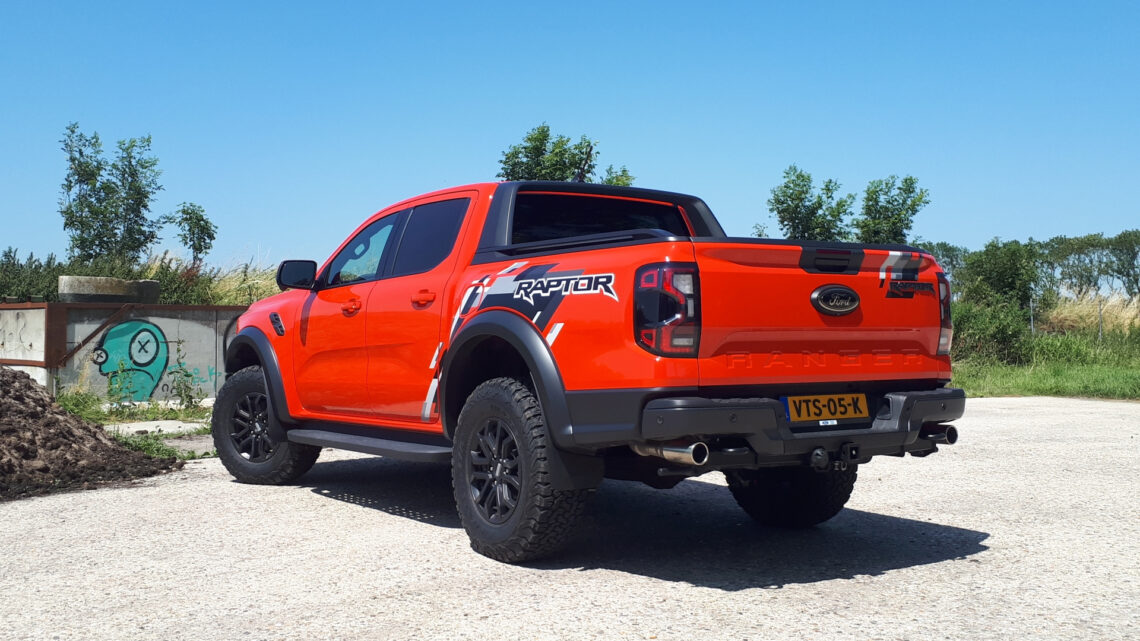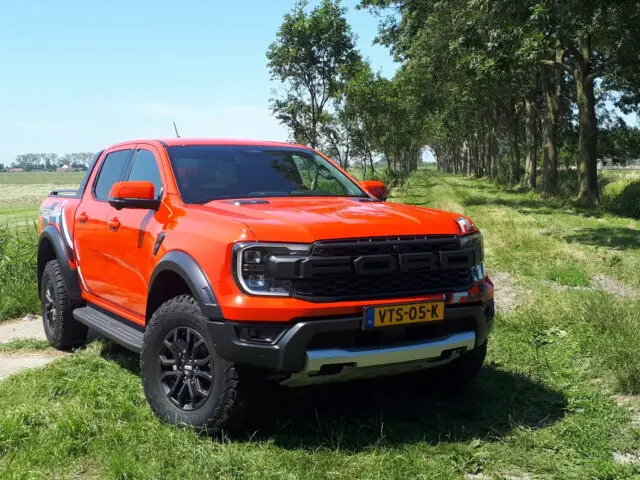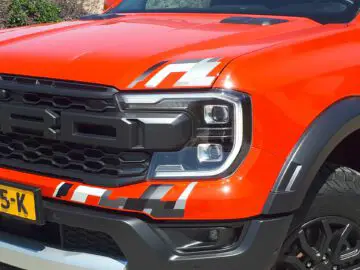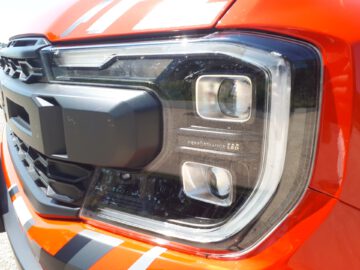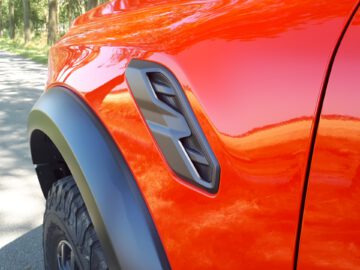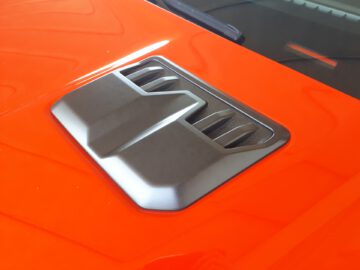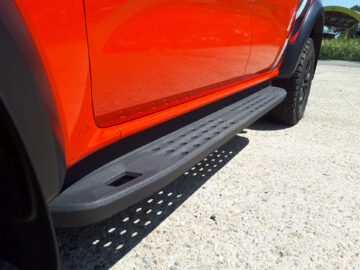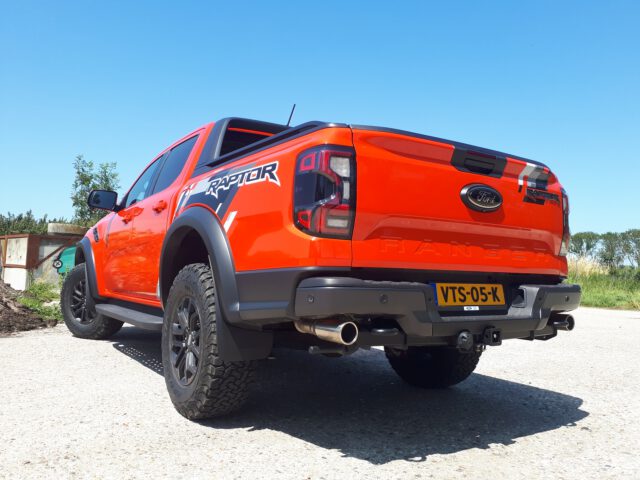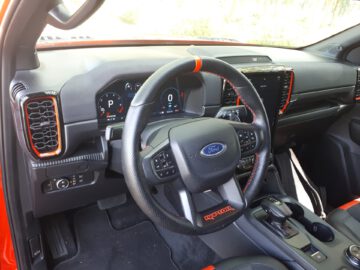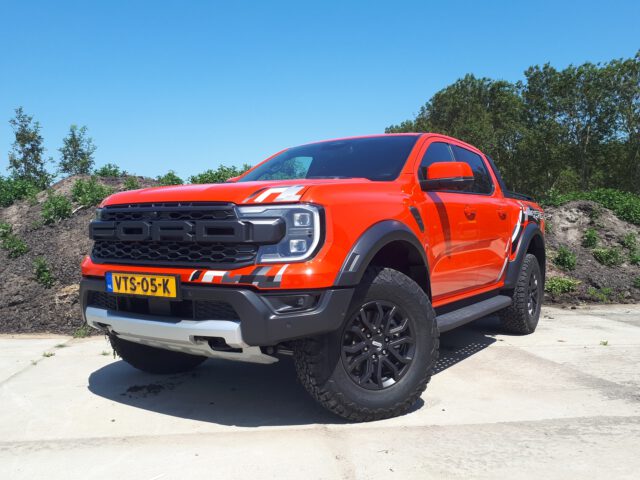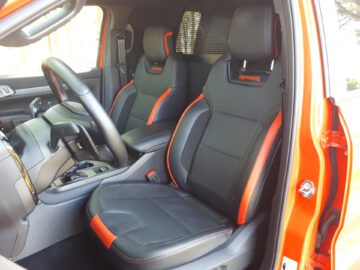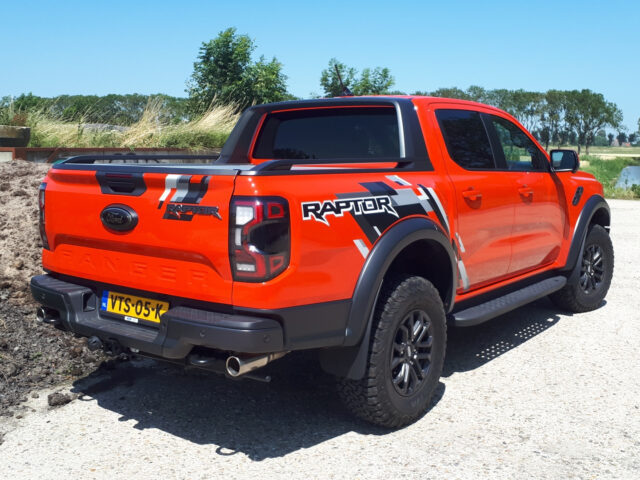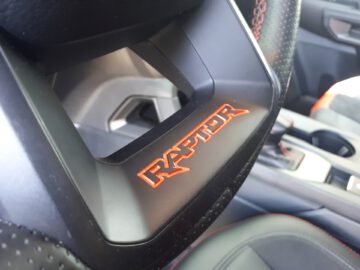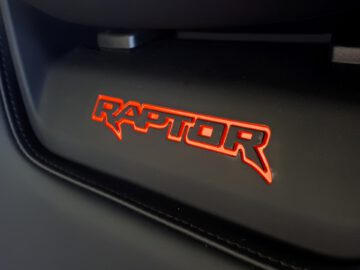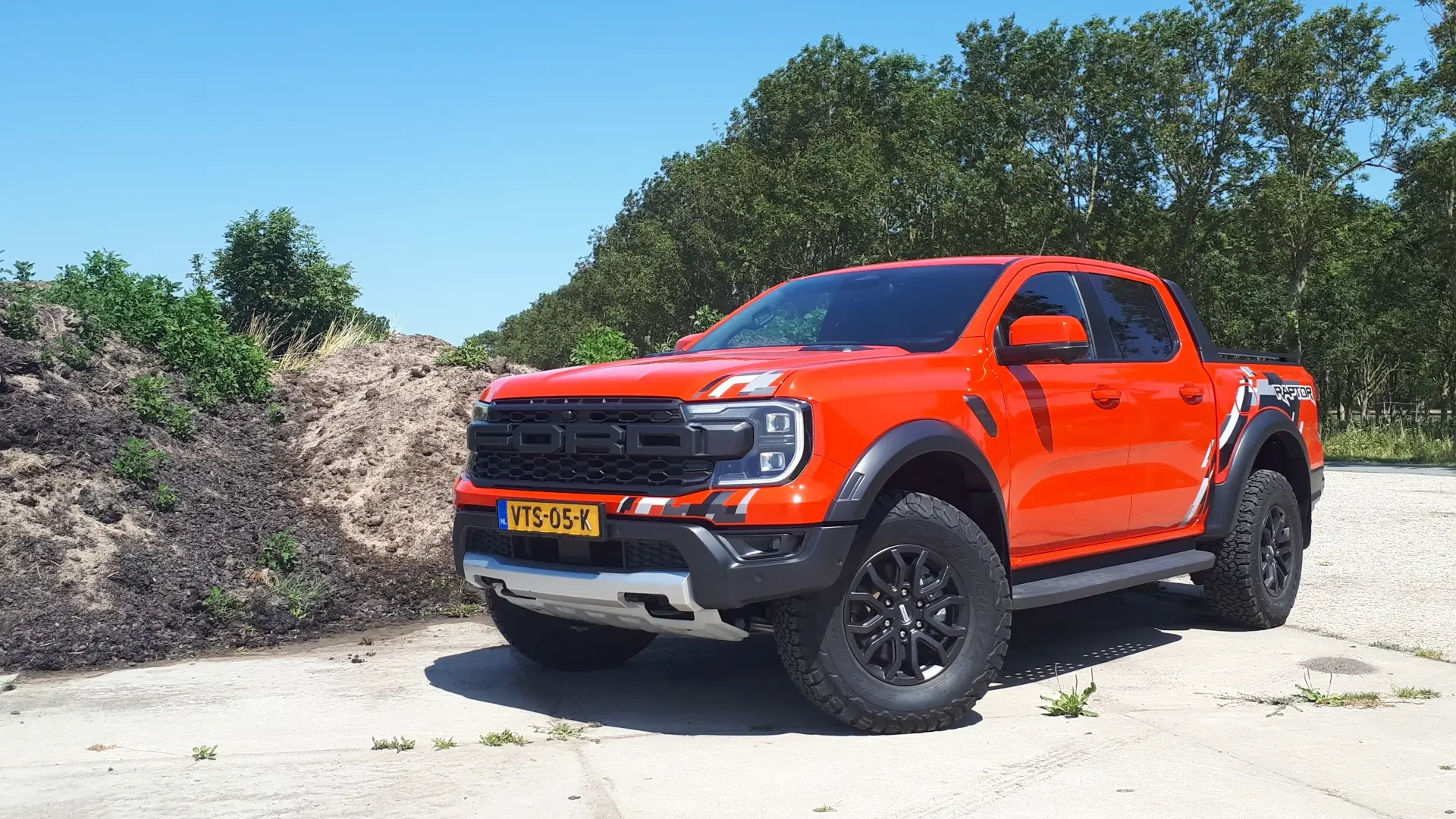Review – Ford Ranger Raptor (2023)
For the 2010 model year, Ford introduced the F-150 SVT Raptor, an extreme off-road version of the popular full-size pickup. It proved a success, and all subsequent model generations of the F-150 received a Raptor version. In 2019, Ford decided to apply the success formula to the “midsize” Ranger as well. There, too, the concept struck a chord. Even here in the Netherlands you still see the first Ford Ranger Raptor driving with some regularity.
Second-generation Ford Ranger Raptor
In 2022, Ford pulled the curtain off the second-generation Ford Ranger Raptor. Meanwhile, the model has made the crossing and we can also take it on the road in Europe. Despite that crossing, by the way, the new Ford Ranger is not necessarily an American pickup. The previous Ford Ranger came from the brand’s Australian branch. The new model builds on that, but with intensified cooperation between the global Ford divisions.
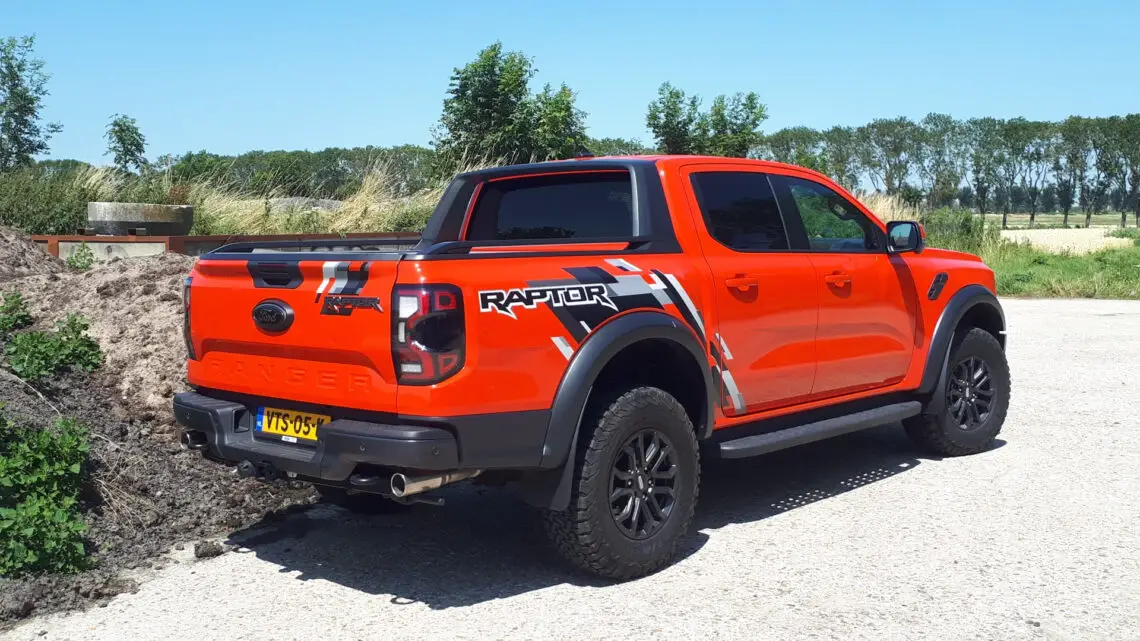
Some structural body parts, the doors and windows were carried over from the previous model. Sheet metal and interior, however, are completely new, and other under-the-hood technology has also been updated to the point where we can truly speak of a new model generation, rather than a facelift. The vast majority of parts are also not directly interchangeable between the new and previous models.
The Raptor formula
The Raptor treatment the Ford Ranger has undergone is obvious at first glance: thick off-road tires, increased ride height and wider wheel arches. In addition, the suspension has been modified so that large obstacles are not likely to be a problem. You can read more technical details about what the Ford Ranger Raptor is all about here.
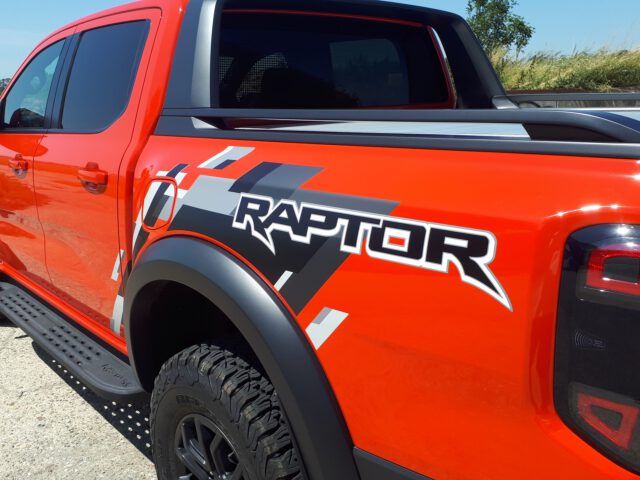

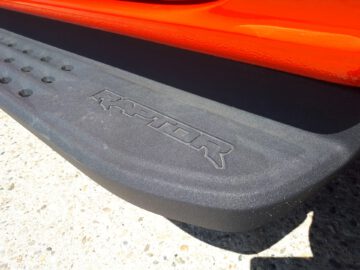
Ford Ranger Raptor on gray license plate
Practical detail: the Ford Ranger Raptor is only available with a double cab, but to make it suitable for the Dutch gray license plate, the rear seat is missing. Also, the left rear side window is blinded. Behind the front seats is an additional partition. It fortunately does not get in the way of the front seats. So you just find a comfortable seating position, without sitting very upright as in many vans. In itself, it is a pity that you cannot go out with four or five. On the other hand, especially if you actually use the pickup for work, such a large and enclosed extra luggage space is also welcome.
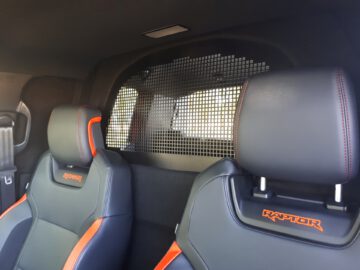
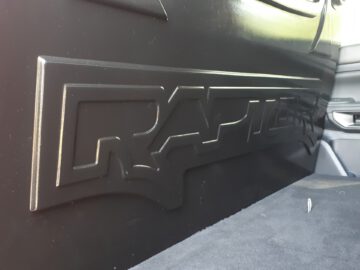
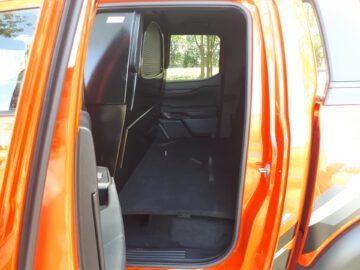
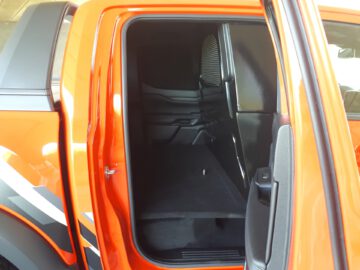
Ford Ranger Raptor now with V6
Like the previous generation, the Ford Ranger Raptor is available with a 2.0-liter four-cylinder diesel engine, which, with 153 kW (205 hp) and 500 Nm, delivers more or less the same performance as the previous model. However, the new Ranger Raptor is also available with “the real thing”: a 3.0-liter V6 gasoline engine. As with big brother F-150 Raptor, you always have a ten-speed automatic (and engageable all-wheel drive, of course).
How much power the V6 delivers varies by market. In North America they have access to the full 302 kW (411 hp); in Australia, with 292 kW (392 hp), they also have no reason to complain. Due to stricter emissions requirements, the power of the European version has been scaled back to 215 kW (292 hp). That, by the way, is still more than enough. Torque is also certainly adequate at 491 Nm. One practical detail: the Raptor modifications reduce the maximum towing weight from 3,500 to 2,500 kg. Still a lot, but still good to consider.

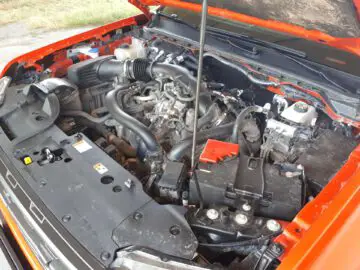

Ford Ranger Raptor is a big boy
It is also the V6 gasoline version waiting for us, in the not-so-subtle color Code Orange. To be honest, the Ford Ranger Raptor is still rather bigger than expected, now that we are standing right next to it. It is “only” the Ranger and not an F-150, but it is still over five feet long. As an expanded Raptor, it just exceeds two meters in width and is also almost as tall.
Time to hit the road. Climbing behind the wheel – for those who are small in stature, the standard running board offers a solution – the car only seems to have gotten bigger. As an indication, the increased ride height means you sit as high in the Ranger Raptor as you would in a standard F-150. Or as high as in the largest Transit model, to stay with European models. Then you also look out over a large flat hood, a powerful feeling. By the way, the high seating position is also very nice for the overview of the road. You often just look over your predecessors and can even better anticipate what is happening in front of you.

Surprisingly agile
Once you get used to the dimensions yourself, they are really not a hindrance at all. The Ford Ranger Raptor is surprisingly well placed. While the rearview camera remains welcome, visibility all around is also not too bad. He also allowed himself to steer effortlessly through the cramped streets of a historic city center – even rewarded with an approving nod from a man sitting on a terrace with his beer. Even a cramped drive-thru of a well-known fast food chain was no problem. As if it was made for it: in addition to cup holders, the Ranger even has a French fry holder.
Contrary to expectations, we also did not experience any parking problems. Okay, that one time we had to file park we just happened to have a nice wide space, but in other places the width poses no problem. Because the car is somewhat less wide at the doors than at the wheel arches, it is still quite possible to get in and out even in fairly tight parking spaces.
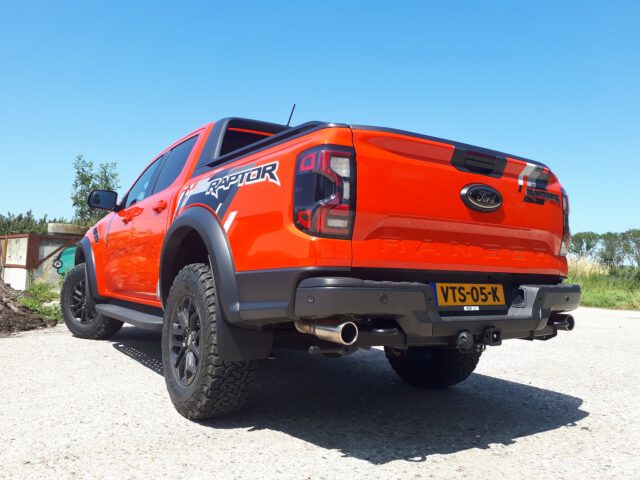

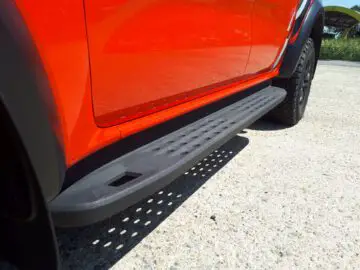
Exceptionally tight handling
On the road, the new Ford Ranger Raptor quickly provides a positive surprise. High on the legs off-road vehicles with off-road tires often do not excel in handling on asphalt, but the Ranger Raptor rides pretty tight. It goes without saying that it does not like fast cornering, but the steering is nicely direct and straight ahead it is nicely steady. Even at higher speeds. The previous model already certainly didn’t drive wrong, but Ford has clearly taken another step forward.
You can drive 130 km/h in comfort with the Ford Ranger Raptor, but it rather invites you to take it easy. Strange as that may sound with some sort of sport version. Nice cruising at about 110 km/h, quietly through the curves, let the rest rush along. Incidentally, the otherwise comfortable seats also offer somewhat little lateral support for fast cornering.
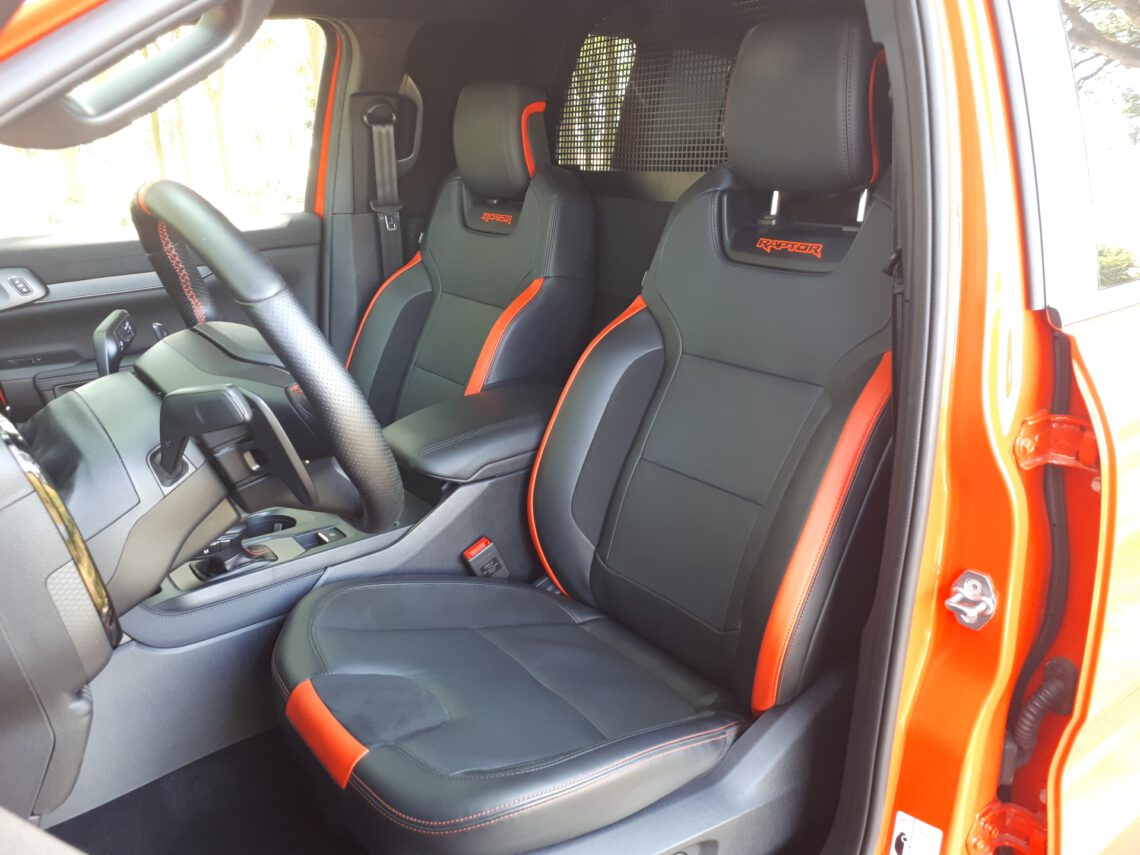
Cruising and sprinting
Between cruising, the Ford Ranger Raptor does invite the occasional sprint, or at least some firmer acceleration. In this respect, the power scaled back for Europe is no problem at all. Even during the sprints, we never for a moment thought “if only we had 100 more horsepower. He’s really getting off his feet this way, too. 100 km/h is reached in 7.9 seconds on paper, but it feels faster. Of course, the relatively modest top speed of 180 km/h is also more than adequate for a car like this.
Thresholds no longer exist
It almost goes without saying that the suspension comfort is also very good. It is notable, however, that short bumps are passed on quite clearly. Even fresh road lines can be felt. Not uncomfortable, but palpable. Major unevenness, on the other hand, is virtually eliminated. Braking for speed bumps is a thing of the past (no really) and even just going straight across raised lane separations at a traffic circle is done with reasonable comfort (but otherwise we behaved nicely, mind you).
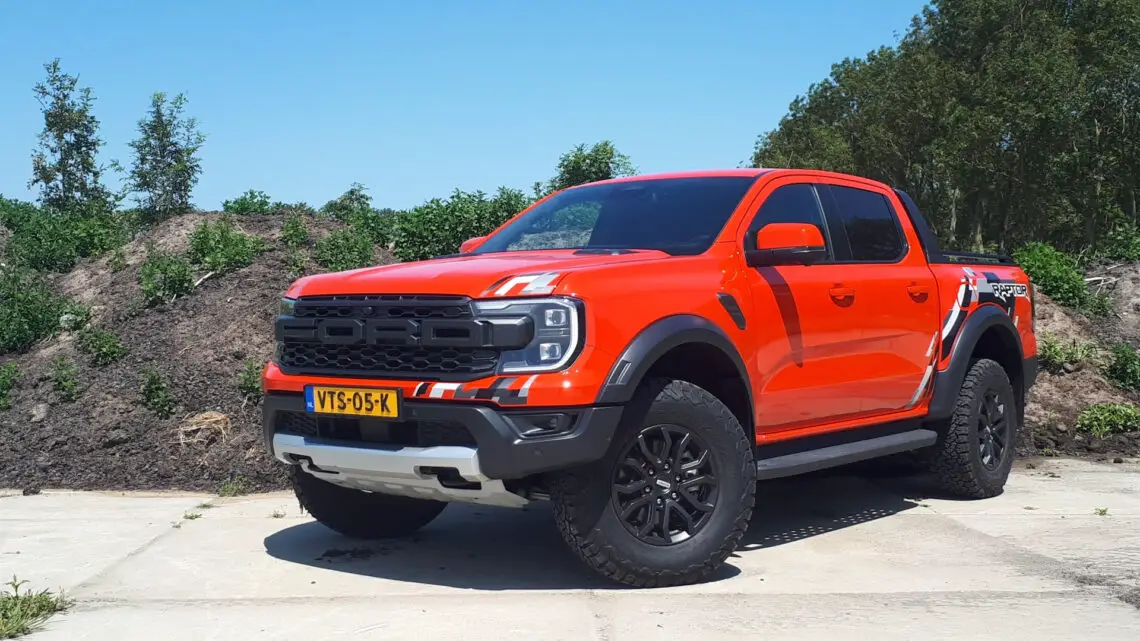
Assistance systems
All the modern driving assistance systems are also just there. Perhaps a little too present. Front Collision Warning, for example, wrongly warned of an approaching collision a few times. Lane assist itself intervenes very subtly, but just a bit too prematurely. So that system soon went out anyway. Fortunately, this is done very easily with a button on the steering wheel. As mentioned, parking assistance systems are welcome, though.
Driving modes: the choice is vast
The Ford Ranger Raptor also offers a variety of handling adjustment options. For asphalt, there is a choice of Normal, Sport and Slippery driving modes. The difference is like other cars: Normal is the most neutral setting. In Sport, the revs are kept a bit higher (read: engine responds more vividly), the steering is a bit heavier and the damping is a fraction tighter.

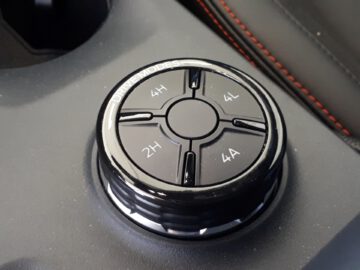

If you go off-road, you have a choice of Rock Crawl, Sand, Mud/Ruts and Baja. The first three speak fairly for themselves. Then the powertrain is matched to the surfaces in question. These drive modes are only for low-speed driving, if only because they lock the transmission into a low gear. Baja is the opposite in that sense: that driving mode is entirely focused on trudging over rough terrain as hard as possible. Just like the Baja races.
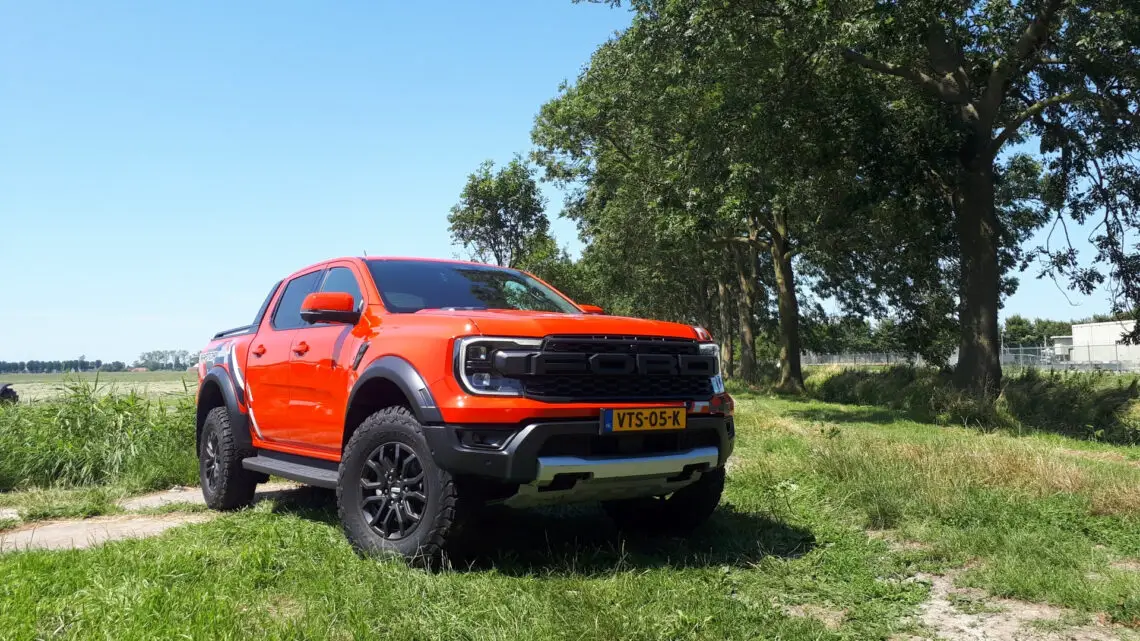
A bit of off road
At times like this, it is a shame that the Netherlands has such a good road network. Unfortunately, we were barely able to drive the Ford Ranger Raptor off-road. We only ride a small stretch of farm track between meadows, with deep mud tracks. With the drought of the past few weeks, grip is not as much of a challenge now, but we can test how easily the Raptor works its way through the deep potholes.
The large ground clearance does prove to add value, and the Raptor works its way effortlessly over the rough trail. That even without too violent body movements. In comparison, the farmer who drove his tractor down the path a little later shook significantly in his cab, while in the Raptor it was like taking a speed bump with a regular car.
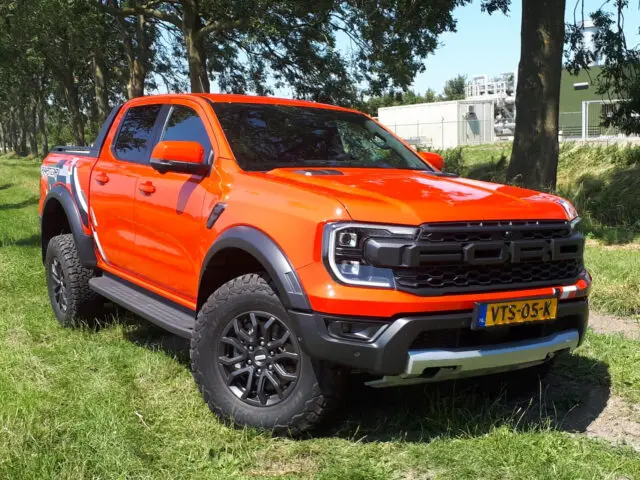
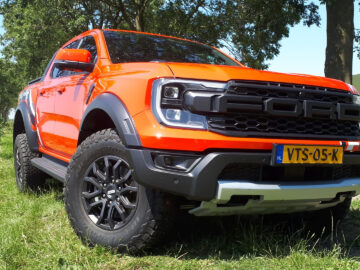

Fully customizable
At the touch of a button on the steering wheel, damping and steering can be adjusted separately from the driving modes. Conveniently, you don’t have to dig through menus via the touchscreen. With these buttons you can choose, for example, to set your everything to Sport except the heavier controls. Or conversely, that in Normal driving mode you still have the slightly softer damping of the Offroad modes. The latter setting is our preference, by the way.
Even the exhaust volume is adjustable at the push of a button. The volume has four levels. In Quiet, you can barely hear the engine idle, and it remains at a modest rumble even on acceleration. In the loudest setting Baja, all the valves open and the Raptor makes itself clearly heard as soon as you touch the throttle. Sounds good! The Normal and Sport modes are in between. Once you have determined your own ideal settings, they can be saved as an additional, personalized driving mode using the R button on the steering wheel.
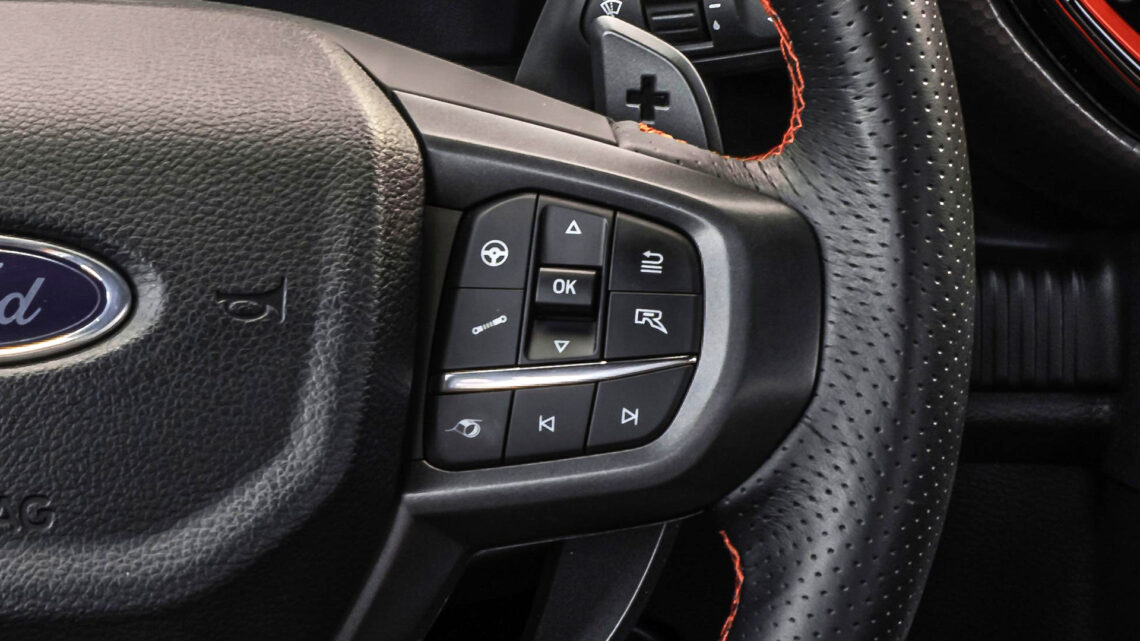
Acoustic comfort
Speaking of sound, the acoustic comfort of the Ford Ranger Raptor is fat. Tire noise is relatively present, especially at higher speeds. That was to be expected with such off-road tires with thick tread. Otherwise, it is just neatly quiet in the interior, there is hardly even any wind noise. In fact, the sound insulation is so good that opening the window almost has more effect on how much you hear from the exhaust than selecting a different sound mode.
Of course, the Bang & Olufsen audio system standard for the Raptor provides great sound. However, certain bass frequencies at slightly higher volume do create a distinct resonance somewhere in the back of the interior. We feel that that vibrating sound is coming from the partition behind the front seats. Eventually, that wall was also added afterwards for the Dutch gray license plate.
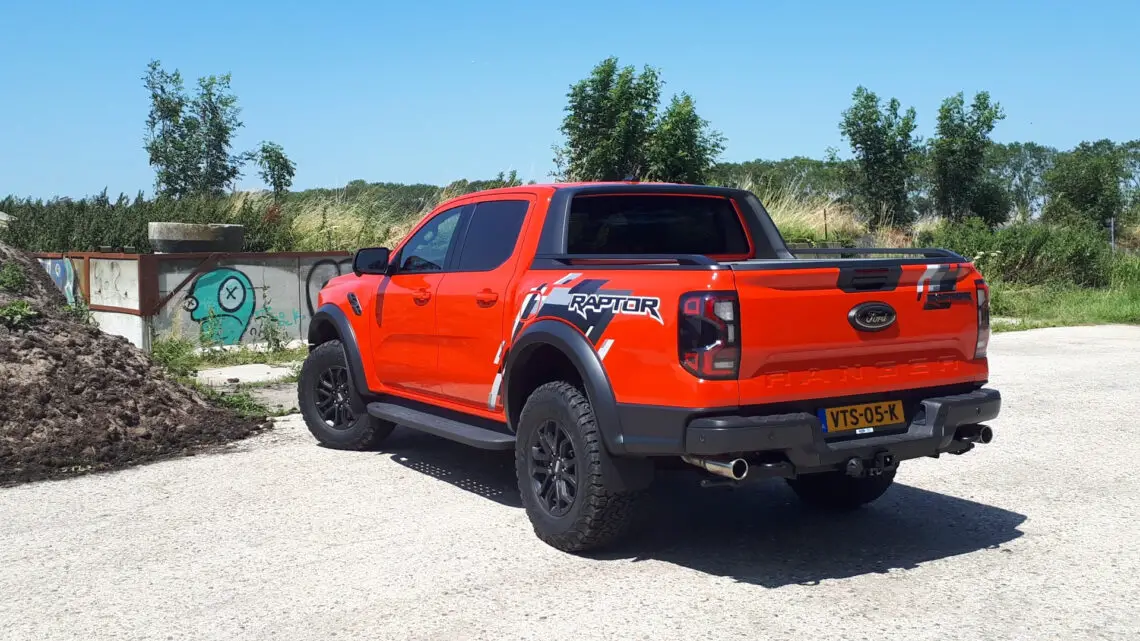
Prices and equipment Ford Ranger Raptor
It’s a good thing that the Ford Ranger Raptor is basically only available on gray license plates in the Netherlands. After all, that still keeps it relatively affordable. It is available from 56,750 euros. A fully standard Ranger comes from 31,510 euros (or 31,310 euros with a bare chassis behind the cab for further bodywork). Then you haven’t checked any options yet. When you look at what you get back in terms of equipment and – above all – experience for the extra cost of the Raptor, we think the price difference is not too bad.
For the full list of equipment and corresponding prices, please visit www.ford.nl, but we’ll pick out a few highlights. Aside from the things already discussed, standard features you get include LED matrix headlights, ten-way power adjustable seats with leather upholstery, the most comprehensive infotainment, tow hitch with power connection and extra cargo box protection.
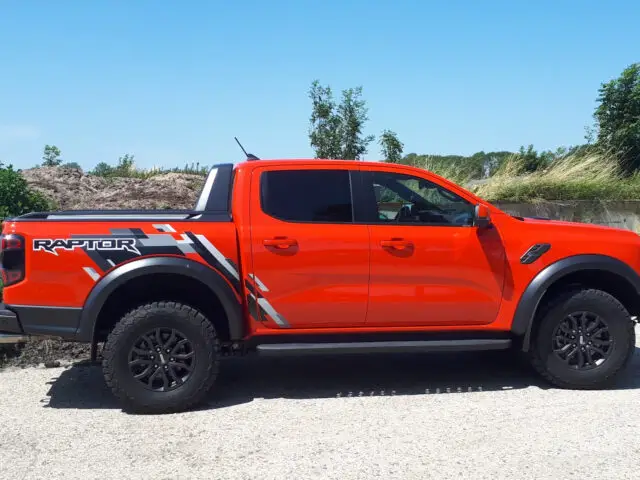
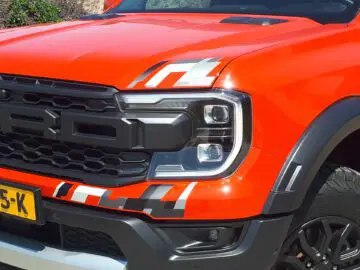
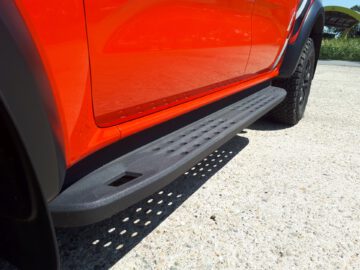
Convenient in themselves are the power outlets in the cargo box, a 12V and even a 230V outlet. You do need an adapter for the latter because of the type of outlet. The electric roll screen over the cargo box of the test car is an option, costing 1,850 euros along with the Sportsbar behind the cab. It also takes some cargo space, but in itself it is nice to be able to fully close the cargo box.
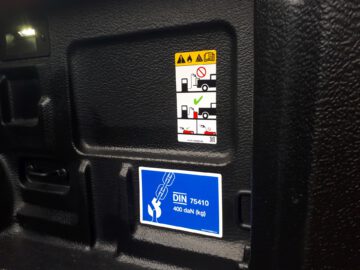

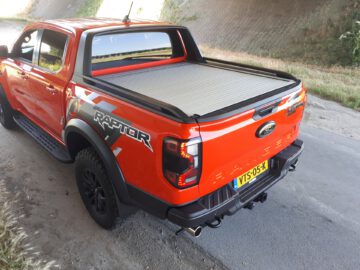
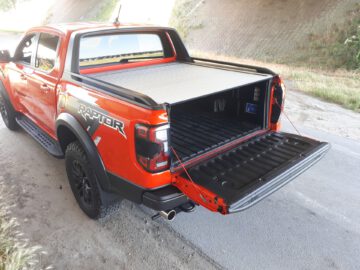
Fuel Consumption Ford Ranger Raptor
For the sake of completeness, let’s discuss it anyway: fuel economy. As expected, the Ford Ranger Raptor is no economy wonder. At the end of our test period, the on-board computer reports average consumption of 11.8 l/100 km (1 on 8.5), or 11.6 l/100 km (1 on 8.6) if we do not include the photo session and the bit of off-road. Still, that’s always better than the official WLTP consumption of 13.8 l/100 km (1 in 7.2). Aside from a few sprints, we just rode quietly with traffic. With the WLTP, they may have accelerated more vigorously.
Conclusion
Frankly, during the testing period, I failed to come up with a rational buying argument for the Ford Ranger Raptor. Or it should be that it is more compact, handy and economical than an F-150 Raptor. The question, however, is how rationally to look at the Ranger Raptor. You buy it mainly because it’s just really nice. You have little use for its very good off-road capabilities in the Netherlands, but even on asphalt every ride is a treat. Otherwise, most of the practical features of the regular Ford Ranger remain.
The combination of looks and sound already made us fall for the Raptor, and in addition, it appears to have fine handling characteristics even on asphalt. Taking part in Dutch traffic with the Ford Ranger Raptor is a bit like the NASCAR car that participated in this year’s 24 Hours of Le Mans: you’re completely out of place, but man what fun it is!
